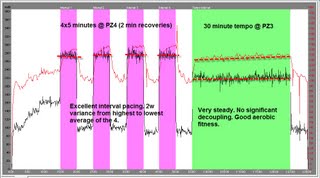Intervals, Tempo and Decoupling
A workout I often have athletes do is a combination of intervals followed by a steady-state tempo. What happens on the steady state tempo says a lot about the athlete’s aerobic fitness.
Here you see a run chart and a bike chart from a single duathlete. The charts are from WKO+ software. He did the run workout first and then the same day did the bike session. Each session involved a warm–up, intervals (pink stripes), a recovery following the intervals, a steady-state tempo (green stripe), and a cool down. Heart rate is the red lines on both charts. Run speed is the blue line. The back line is bike power. This athlete has greater experience as a cyclist than as a runner and his bike fitness tends to exceed his run fitness. This also shows up in his approach to each session.
RUN
In this chart (click to expand) he was doing 800m intervals on a track at just a bit slower than his 5k but faster than 10k pace. After each interval he did a 200m jog to recover. Each recovery was just slightly shorter in duration than the preceding work interval. Notice how he started each work interval at the fastest pace of the interval and gradually slowed down with the exception of the last where he finally settled in to a good pace initially. And he gradually got slower on each subsequent interval with the exception of the third which was his second fastest (but had the greatest pacing variability). I believe this positive-split pacing (start fast, finish slow both within and between intervals) is, in part, reflective of his more limited experience as a runner.
work interval at the fastest pace of the interval and gradually slowed down with the exception of the last where he finally settled in to a good pace initially. And he gradually got slower on each subsequent interval with the exception of the third which was his second fastest (but had the greatest pacing variability). I believe this positive-split pacing (start fast, finish slow both within and between intervals) is, in part, reflective of his more limited experience as a runner.
I was also very interested in his 10-minute, heart rate zone 3 tempo run following the intervals. Besides making for a great workout, I do this to see how aerobically fit the athlete is. Near the end of a challenging workout finding how speed responds when heart rate stays constant is a good indicator of the athlete’s aerobic fitness. Here you can see that speed drops off. Heart rate and pace ‘decoupled.’ They are not parallel. He has more work to be done on aerobic fitness yet which is all the more reason to be very cautious with pacing early in a race. Going out too fast will cause a significant drop in speed later in the race. If his aerobic fitness was higher, pacing would not be quite as much of a problem.
BIKE
Here you see his bike workout with 5-minute intervals done at power zone 4 which is roughly 40km time trial power for him. Th e recovery intervals were short at about two minutes each. Notice how beautifully he paced the intervals. They are steady and consistent. As a coach, this is so beautiful it brings tears to me eyes. :)
e recovery intervals were short at about two minutes each. Notice how beautifully he paced the intervals. They are steady and consistent. As a coach, this is so beautiful it brings tears to me eyes. :)
Then notice how steady his 30-minute, power zone 3 tempo was. The two lines (heart rate and power) remain nicely 'coupled,' just like railroad tracks. His aerobic fitness on the bike exceeds his run aerobic fitness.
It’s apparent we still need to work on two things: run pacing and run aerobic fitness. He has made great gains as a runner. Had he done this same run workout a few weeks ago the decoupling would have been much more evident. And his running race times at 5km indicate that he is, indeed, making great progress. Stellar run performance takes a long time to achieve, as in years, but his progress has actually been quite exceptional due to his determination and discipline.


13 Comments:
joe,
love this post....learned decoupling and now I can watch for that on my charts....gonna look at some right now!! :)
I've read some of your posts that you like to see athletes descend into a TT or race.
in other words, instead of averaging 280 watts steady, avg 265, 275, 285 and 295 and get the same resulting 280 average.
does this have any benefit with the workout you describe?
I feel better when I descend into a race effort, even though my wattage is the same overall average, holding back and finishing stronger that I started has benefits.
but maybe this does not apply to the workout you describe?
also, I assume this must be a trainer workout, cannot imgaine anyone holding steady watts like that on the road...do you feel trainer workouts are better suited for interval work like this?
Hi Mike--Good questions. I'll take a stab at them...
1. When it comes to race pace/effort one of the best things an athlete can learn is patience. negative splits/descending times or power is a great way to learn this. Once obviously understood then steady pacing on all the intervals is fine, as he did on the bike here but failed to do on the run.
2. A trainer can make such a workout more steady since you can control the variables almost entirely. However, since races are almost always done on the road, the closer you get to the race the more intervals should be done on the road also.
Really GREAT post! I'm going to look at some of my charts a little more closely. Thanks! Very informative!!!
Joe
How much did weather/hydration have to do with the first example of decoupling? These factors would effect pace/power wouldn't they?
Sam, Australia.
Sam--I don't believe they had anything to do with the results. In that regard, the bike results would have been worse. They were better.
Good information on how to assess aerobic fitness. Thanks so much.
Hi Joe. You being a coach, I thought you would find this this article interesting. Your comments are most welcome.
Hi Joe,
1. I have a recommendation for improving the Triathlete’s Training Bible. On page 281, bottom paragraph, you explain the importance of novices focusing on aerobic endurance during their first year. You don’t mention how a novice knows when they’ve reached an aerobic base. I would tell the reader to revisit pages 59 and 60 to refresh on decoupling. This would help reinforce the purpose of using decoupling to measure aerobic fitness.
2. Is the following situation a case of decoupling? After a warm-up for a 10k my HR is zone 2 and my intended zone is 4. It takes 4 miles running at race pace to reach zone 4 from zone 2, and the HR and pace remain coupled afterwards. Since the HR is slowly rising for the first 4 miles is this a case of decoupling?
David
Hi David--Thanks for the suggestion. Much appreciated. Decoupling means HR is rising reltive to power/speed or power/speed is falling relative to HR.
Is there a good way to control or reduce decoupling? For example if I do some inline skating, I can have days where all the zones are appropriate - and on other days within minutes of starting my heart monitor says I am in zone 5 even though I know my effort and pace are not at a zone 5 level. This is true whether cycling, swimming or skating and I cannot seem to correct the problem - I though I had adequate aerobic base, but maybe not???
Cliff--If by zone 5 you mean anaerobic then decoupling is normal. The examples I gave here were using zone 2.
Unbelievable how aerobic base in the two disciplines can vary SO MUCH! Intuitively I'd think that "aerobic base is aerobic base" with SOME variation or preference to one or the other sport.
On the same account it's incredible to see how an athlete who is able to pace himself so well on the bike is obviously not quite so able to accomplish the same on the run.
Based on the HR levels it appears the run workout was more stressful than the bike intervals. I wonder if the decoupling on the run would have been closer to the run if the 5 min running intervals were a little easier?
Post a Comment
<< Home